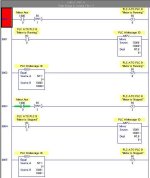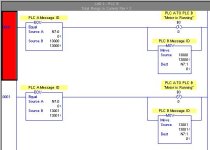Vetteboy
Member
- Join Date
- Jul 2002
- Posts
- 380

I am about to implement the Global Status Flags on my DH+ network of PLCs and I am thinking about using the integers in the files instead of individual bits. This would mean using a message number to communicate between PLCs and I want to be sure that no message is ignored. I am attaching the logic I would like to use and I am looking for any pointers that may improve the process. Maybe with all the extra instructions I'm better off going with a MSG. I just thought using integers that I could have hundreds of messages instead of being limited to the 16 bits for each node.
On PLC A I want to Indicate to PLC B that a motor is running. I am latching the bit until PLC B can echo the message back to indicate it has received that message. In this example N7:0 is the global status word for PLC A, and N7:1 is PLC B. The "motor is running" message is number 13000, and the "motor is stopped" message is 13001.

On PLC A I want to Indicate to PLC B that a motor is running. I am latching the bit until PLC B can echo the message back to indicate it has received that message. In this example N7:0 is the global status word for PLC A, and N7:1 is PLC B. The "motor is running" message is number 13000, and the "motor is stopped" message is 13001.

Last edited:




